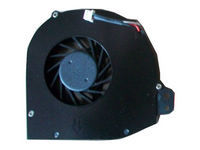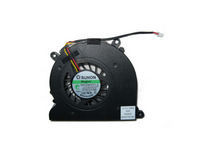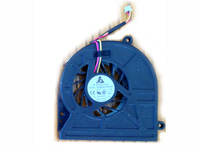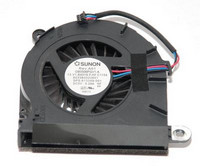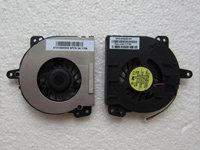A lot of friends reaction own computer too much noise noise. Actually the biggest culprit is CPU fan. Generally speaking, the new buy fan always noise is small, and the use of a period of time will be significantly bigger. In fact, the dust caused by fan noise is one of the important reasons for rising, because all-pervasive dust can always drilling incomplete airtight case. When the CPU fan high speed rotates, the whirlpool effect makes the dust is easy to adhere to the fan on. There is no doubt that at this time will CPU fan tear open come down to clean a is very necessary, and in the dust out, we should pay attention to fan back and fin of crack, here is the most easily forgotten.
Fan back and fin of crack don't forget to clean up, here is very easy to accumulate dust
For oil bearing fan is concerned, motor cpu fan drive shaft after a long time work less flexible is often the things. Therefore, suggest that we in this position add lubricating oil, recommend mechanical lubricating oil or gasoline engine oil. Of course, in the add lubricating oil must be careful, do not let it overflow.
In addition, the vibration problem is also need our attention, usually high speed rotating fan and cooling fin occurred high frequency collision, if the fan and cooling fin then stable appropriate, collisions vibration noise can be greatly reduced. Such as the high speed rotating CPU fan take in hand, the noise is far less than the fixed in the radiator, this is because the soft hands absorbed a large number of vibration. According to this principle, in the fan corners and fin between contact with 1 ~ 2 mm thick soft gasket (such as leather, rubber), can effectively reduce the fan and cooling fin vibration produced by the noise.
Special fan governor, some fans cpu fan have the speed regulating function
In the summer, many users can choose to stop overclocking, the high power fan obviously is unnecessary. Lead to fan sound too much the most main reason is that it extremely high speed. If we will fan droop down, so the noise problem will be further ease. In fact, even if we use the CPU fan can't adjust speed, we can also through the special fan governor and make up. ZALMAN company launched FAN MATE1 FAN governor in the domestic market is very popular, kyushu Aeolus have similar products. The use of this kind of fan governor is very simple, you only need to will CPU fan power interface on fan governor, and then fan governor connection on the mainboard CPU fan power interface can be.
As for the beginning ability strong user, you can try to reduce the working voltage of the series resistance method. As for the resistance value, we can use the CPU fan on the nameplate calculation (remember P = UI, R = U/I can), and at this time we can get any voltage. Want to remind everybody cpu fan finally, reduce the CPU fan speed after, must in the BIOS open the corresponding temperature monitoring function, to ensure safety. Of course, when that can put the alarm temperature and shutdown temperature setting a few higher.
Fan back and fin of crack don't forget to clean up, here is very easy to accumulate dust
For oil bearing fan is concerned, motor cpu fan drive shaft after a long time work less flexible is often the things. Therefore, suggest that we in this position add lubricating oil, recommend mechanical lubricating oil or gasoline engine oil. Of course, in the add lubricating oil must be careful, do not let it overflow.
In addition, the vibration problem is also need our attention, usually high speed rotating fan and cooling fin occurred high frequency collision, if the fan and cooling fin then stable appropriate, collisions vibration noise can be greatly reduced. Such as the high speed rotating CPU fan take in hand, the noise is far less than the fixed in the radiator, this is because the soft hands absorbed a large number of vibration. According to this principle, in the fan corners and fin between contact with 1 ~ 2 mm thick soft gasket (such as leather, rubber), can effectively reduce the fan and cooling fin vibration produced by the noise.
Special fan governor, some fans cpu fan have the speed regulating function
In the summer, many users can choose to stop overclocking, the high power fan obviously is unnecessary. Lead to fan sound too much the most main reason is that it extremely high speed. If we will fan droop down, so the noise problem will be further ease. In fact, even if we use the CPU fan can't adjust speed, we can also through the special fan governor and make up. ZALMAN company launched FAN MATE1 FAN governor in the domestic market is very popular, kyushu Aeolus have similar products. The use of this kind of fan governor is very simple, you only need to will CPU fan power interface on fan governor, and then fan governor connection on the mainboard CPU fan power interface can be.
As for the beginning ability strong user, you can try to reduce the working voltage of the series resistance method. As for the resistance value, we can use the CPU fan on the nameplate calculation (remember P = UI, R = U/I can), and at this time we can get any voltage. Want to remind everybody cpu fan finally, reduce the CPU fan speed after, must in the BIOS open the corresponding temperature monitoring function, to ensure safety. Of course, when that can put the alarm temperature and shutdown temperature setting a few higher.

